
The Cathedral of St. Michael and St. Gudula, usually shortened to the Cathedral of St. Gudula or St. Gudula by locals, is a medieval Roman Catholic cathedral in central Brussels, Belgium. It is dedicated to Saint Michael and Saint Gudula, the patron saints of the City of Brussels, and is considered to be one of the finest examples of Brabantine Gothic architecture.

Saint Pharaildis or Pharailde is an 8th-century Belgian virgin and patron saint of Ghent. Her dates are imprecise, but she lived to a great age and died on January 5 at ninety.
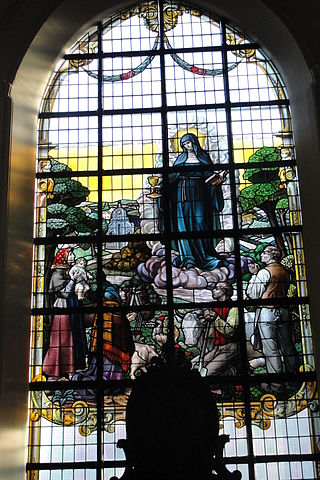
Berlinda was a Benedictine nun of noble descent. Her feast day is 3 February. According to legend she was a niece of Amandus, and was disinherited by her father, Count Odelard, after he became sick with leprosy and believed that she would not take proper care of him.
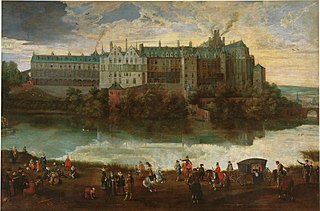
The Palace of Coudenberg was a royal residence situated on the Coudenberg or Koudenberg, a small hill in what is today the Royal Quarter of Brussels, Belgium.
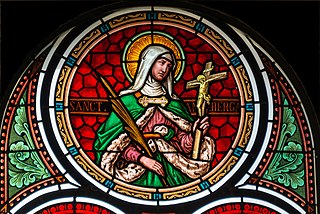
Saint Amalberga of Maubeuge was a Merovingian nun and saint who lived in the 7th century.

Amalberga of Temse was a Lotharingian noblewoman from the Frankish royal house of the Pippinids who is celebrated as a saint in the Roman Catholic Church and the Eastern Orthodox Church. She is especially venerated in Temse, Ghent, Munsterbilzen and other parts of Flanders. She received the veil from Saint Willibrord of Echternach.
Emebert was an early Bishop of Cambrai, in northern France; he is often identified with Bishop Ablebert of Cambrai.
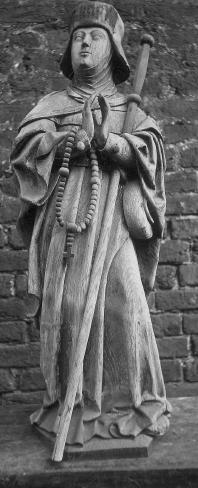
Reineldis was a saint of the 7th century, martyred by the Huns.

Alice of Schaerbeek, was a Cistercian laysister who is venerated as the patron saint of the blind and paralyzed. Her feast day is 15 June.
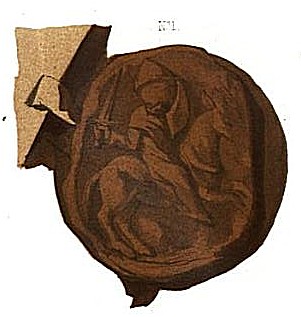
Lambert II was count of Leuven between 1033 and 1054. Lambert was the son of Lambert I of Louvain.

Saint-Géry Island or Sint-Goriks Island was the largest island in the river Senne in Brussels, Belgium. It was named after Saint Gaugericus of Cambrai, who according to legend, built a chapel there around 580. It ceased to exist as an island when the Senne was covered over in the late 19th century, and a former covered market; the Halles Saint-Géry/Sint-Gorikshallen, was built in its centre. Since the late 20th century, this building has been rehabilitated as an exhibition space.

Moorsel is a village in the Denderstreek in the province East Flanders in Belgium, a deelgemeente of the city of Aalst. The village belongs to a league of neighbouring villages, which call themselves the Faluintjesgemeenten. Moorsel is the largest of the four villages with approximately 5,175 inhabitants as of 2021.

The Fortifications of Brussels refers to the medieval city walls that surrounded Brussels, Belgium, built primarily to defend the city but also for administrative reasons. There were two stages of fortifications of Brussels: the first walls, built in the early 13th century, and the second walls, built in the late 14th century and later upgraded. In the 19th century, the second walls were torn down and replaced with the Small Ring, a series of boulevards bounding the historical city centre. Nowadays, only a few sections of each walls remain, most notably the Halle Gate.
Joseph Borremans was a composer, organist and conductor in the United Kingdom of the Netherlands.

The Brussels massacre was an anti-Semitic episode in Brussels in 1370 in connection with an alleged host desecration at the Brussels synagogue. A number of Jews, variously given as six or about twenty, were executed or otherwise killed, while the rest of the small community was banished. The event occurred on May 22.

Joannes Roucourt was a Christian theologian and the parish priest of the Saint-Gudula Church at Brussels from 1667 until 1676. As a pastor, he was known as "father of the poor".
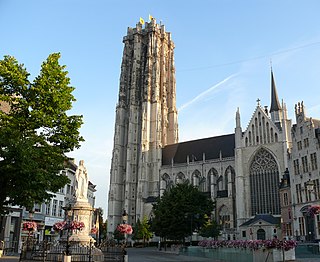
The Archdiocese of Mechelen–Brussels is a Latin Church ecclesiastical territory or archdiocese of the Catholic Church in Belgium. It is the primatial see of Belgium and the centre of the ecclesiastical province governed by the Archbishop of Mechelen–Brussels, which covers the whole of Belgium. It was formed in 1559 and the bishop has a seat in two cathedrals, St. Rumbold's Cathedral in Mechelen and the Cathedral of St. Michael and St. Gudula in Brussels. The current archbishop is Luc Terlinden, who was installed in September 2023.
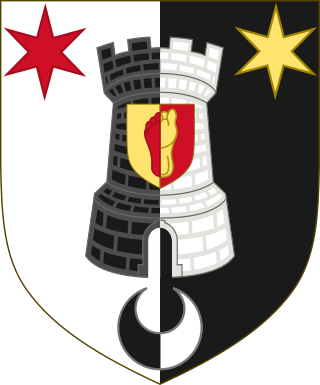
The Van Dievoetfamily is a Belgian family originating from the Duchy of Brabant. It descends from the Seven Lineages of Brussels and its members have been bourgeois (freemen) of that city since the 1600s. It formed, at the end of the 17th century, a now extinct Parisian branch which used the name Vandive.
The pagus of Brabant was a geographical region in the early Middle Ages, located in what is now Belgium. It was the first region known to have been called Brabant, and it included the modern capital of Belgium, Brussels.
Petrus de Thimo, Latinized name of Peter van der Heyden, was a Brabantine chronicler and a lawyer employed by the city of Brussels, of which he became Pensionary in 1423. He is considered one of the most important 15th-century chroniclers of the Duchy of Brabant.

















